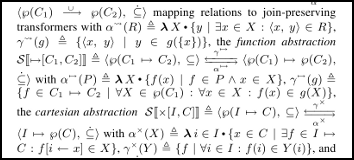Economy of Style
Posted by Tom Leinster
John Regehr writes: “holy cow this Cousot+Cousot paper achieves a density I’ve never before seen.” Me neither!
Much of the paper looks like the snippet shown, except for the part where they take the time to explain that “e.g.” means “for example”. Read this Twitter thread for speculation on how this state of affairs came to be.
Posted at September 3, 2016 1:25 PM UTC

Re: Economy of Style
The symbology actually looks decipherable to me, but I didn’t see a statement of a theorem on a quick glance.